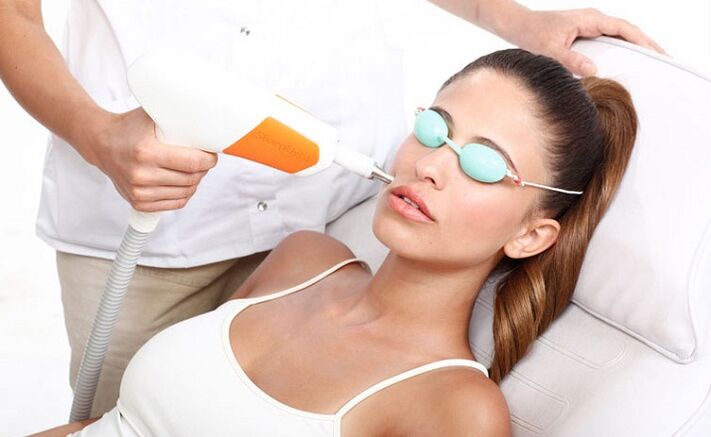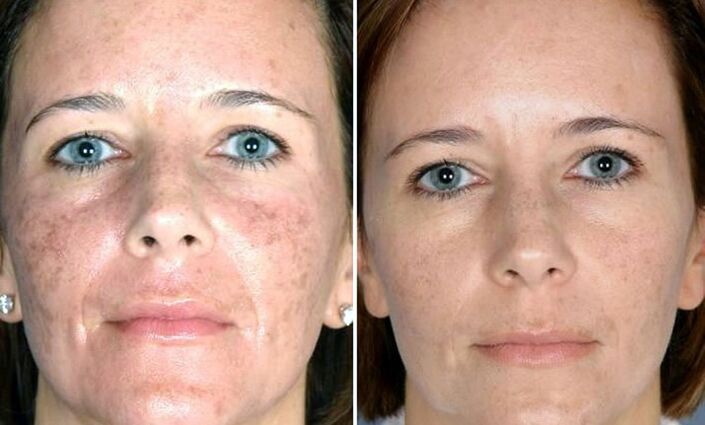From the time of Cleopatra to the present day, there is not a single representative of the sex who does not want to prolong the age and beauty of her skin. Modern medical science has never ceased to amaze with innovations in the field of cosmetology, which offers a wide range of surgeries and anti-aging procedures.
Especially popular are techniques that allow you to get rid of the signs of external aging without the use of a scalpel or Botox injections. Fractional laser rejuvenation is now the fastest and safest method to combat skin aging.

What is a fractional laser and how does it "rejuvenate"
When the laser touches the skin, burns occur that spread deeply. The process of active healing (regeneration) begins, which gives the desired cosmetic effect. This procedure is also known in facial makeup as a laser skin surface protector.
If the same laser is divided into many micro -rays, then the aforementioned fractional laser beam will be obtained. Such rays will no longer act on the skin as a whole, but as intermittent microgrids. Burns after fractional laser thermolysis are located in the form of a large number of microdots between intact skin. This significantly reduces the trauma of the procedure (as well as the pain) and allows the skin to recover more quickly.
After being exposed to the laser, intact healthy skin cells begin to actively divide, with the formation of collagen and elastin, which give the skin elasticity and a youthful appearance.
Varieties of fractional photermolysis
Ablative
Under the action of laser radiation, water evaporates from the tissue and an "open" microscopic wound is formed, around which the damaged (burned) cells are located.
In the healing process, a significant lifting effect occurs, but there is a danger of infection penetrating into the deep layers of the skin.
Not ablative
Radiation is applied, which keeps the epidermis intact, so that evaporation from the tissue and the formation of "open" wounds do not occur. Burns form and heal under the epidermis, so there is no risk of infection, but the rejuvenating effect of this procedure is less obvious.
Cosmeticians choose fractional rejuvenation methods individually, depending on the condition and type of skin.
Effects and Benefits of Fractional Laser Thermolysis
The main difference between the technique and all other procedures is the optimal balance between safety and effectiveness.
Key additions:
- the ability to affect any part of the body (including décolleté, neck, eyelids);
- various clues;
- physiology (damage area is only 20% of the total area treated with laser);
- short healing period (2-7 days);
- methods of anesthesia - application;
- the possibility of using it in people with dark skin (because it does not cause hyperpigmentation);
- the duration of the result (from one year to several years).
The disadvantage is the insufficient knowledge of all aspects of the fractional laser effect, as the technology itself has emerged recently.
Indications for fractional rejuvenation:
- wrinkles (from depth and location);
- decreased elastic properties of the skin;
- enlarged pores;
- pigmentation;
- acne;
- spider veins;
- scars (after surgery, residue after acne);
- stretch marks (striae), including on the skin of the mammary glands.
Features performing fractional laser thermolysis
A few days before the photothermolysis procedure, the cosmetologist may prescribe (if indicated) antibacterial or antiviral drugs in prophylactic doses.
On the day of fractional rejuvenation, it is necessary to completely get rid of physical activity, smoking and alcohol intake.
Before the procedure, the skin is thoroughly cleansed and treated with a special anesthetic cream. In some cases, anesthesia is not needed at all.
The laser effect is felt as "tingling" or "tingling". The duration of the procedure (from a few minutes to an hour) and the amount are chosen individually. After the laser treatment, a soothing nourishing cream is applied to the skin.
Follow -up skin care:
- Moisturize the skin with a special cream 2-3 times a day (within 2 weeks);
- protect the skin from UV rays for 2 months (do not visit the solarium, use sunscreen with a protection factor of at least 30);
- do not use skin and rub (within 2 weeks);
- do not use cosmetics containing salicylic acid and retinol (within 2 weeks);
- do not wear compression underwear for several days (if fractional photothermolysis is performed on the body);
- limit (exclude) smoking and alcohol for the entire treatment (reduce skin regeneration function).

On average, the recovery period lasted up to 3 days after non-ablative fractional laser thermolysis and up to 7 days after ablative thermolysis.
The skin changes after the procedure
For 1-3 days after intense laser exposure, redness, discomfort and slight swelling of the skin may persist. If this condition is subjectively intolerable, then it is permissible to use painkillers and skin cooling.

After a few days, a bronze skin color (tanning effect) may appear, which can last up to 2 weeks and disappear on its own. Within 5-7 days after fractional rejuvenation, dryness and exfoliation of the skin was observed.
Undesirable consequences and contraindications to photothermolysis
With improper skin care after the procedure, non -compliance with recommendations, or technical errors during laser treatment, the following complications are possible:
- redness of the skin lasting more than 3 days;
- edema at the site of exposure, lasting more than 2 days;
- increased herpes infection (if previously in the treatment area);
- infection (appearance of streptoderma);
- erosion, burns in the affected area;
- precise bleeding;
- hyperpigmentation.
To avoid unwanted consequences, fractional laser rejuvenation procedures are performed after examination and exclusion of possible contraindications.
Absolute contraindications:
- pregnancy and breastfeeding;
- tendency to form keloid scars;
- acute infectious processes (including herpes);
- oncological pathology;
- conditions after radiation, chemotherapy;
- epilepsy;
- significant disorders of the immune system;
- taking medications that contain retinoids;
- psoriasis (atopic dermatitis) during exacerbations.
Relative:
- renal pathology;
- diabetes;
- inflammation at the site of exposure;
- patient refusal to follow the recommendations of a beautician;
- mental illness;
- allergies to anesthetics;
- autoimmune diseases;
- fresh tan (visit to the solarium in the last month);
- recent rejuvenation procedures (affecting the inner layers of the skin - in the last three months, superficial - in 10 days).
Reviews of fractional laser rejuvenation and patient photos from the "before" and "after" series generally undermine the effectiveness and low trauma of this method for preserving adolescence.

Remember!This procedure can only be performed by a specialist (surgeon or dermatovenerologist) who has been trained and has permission to work with the laser device. The competence of a doctor is the key to your beauty!













































































